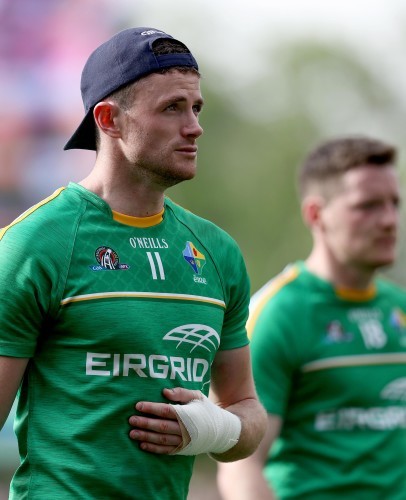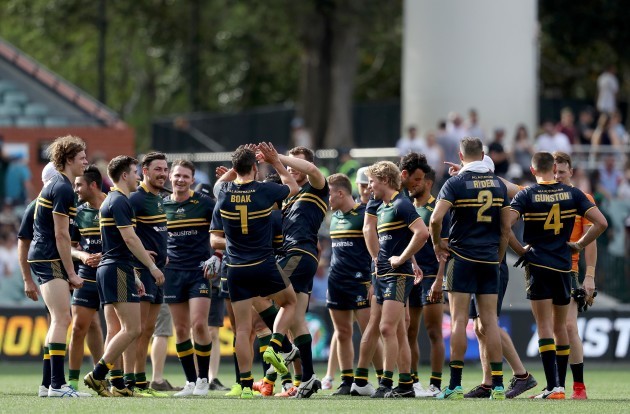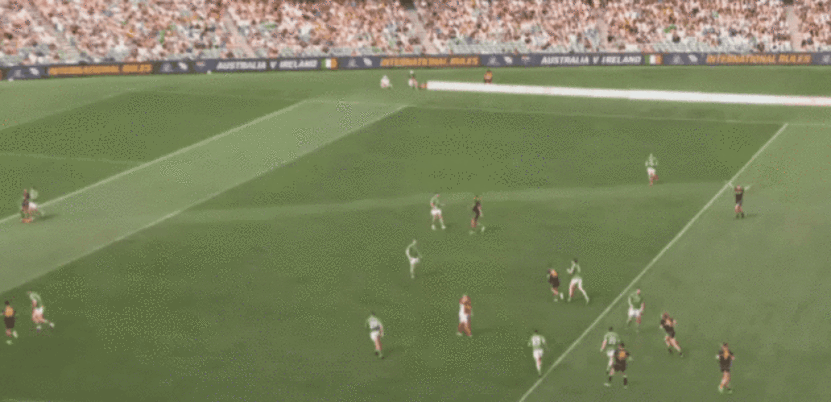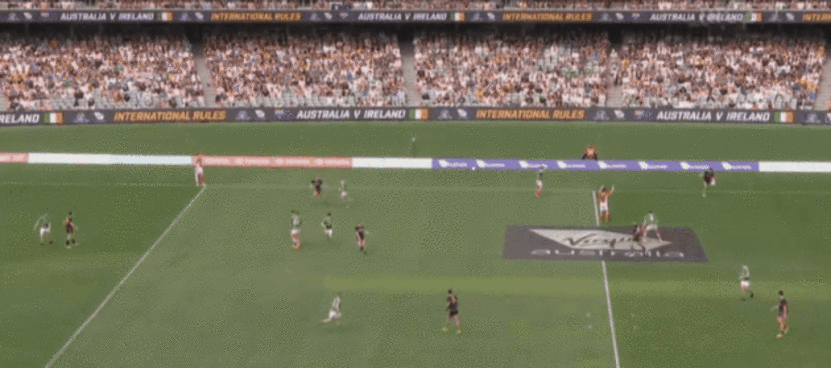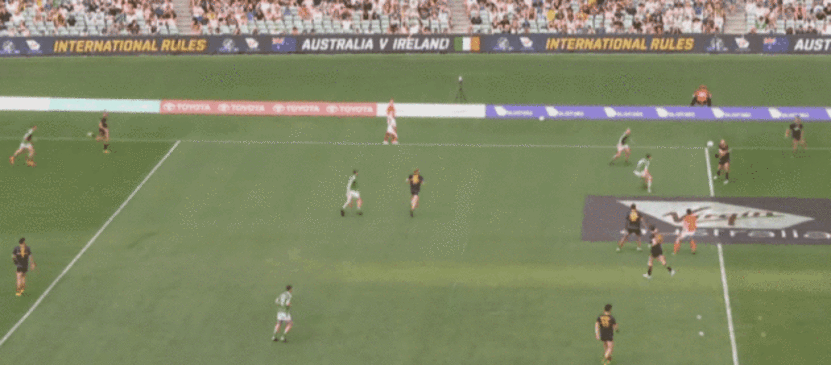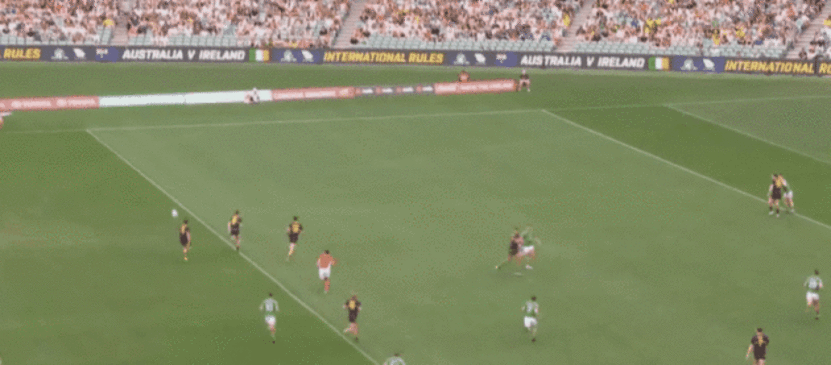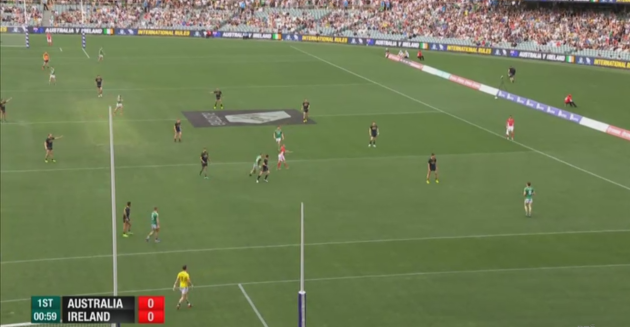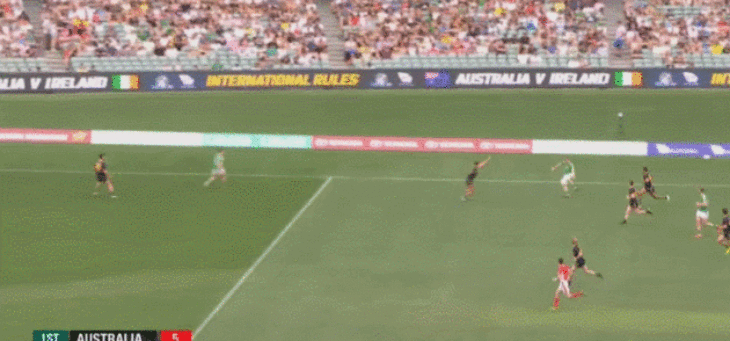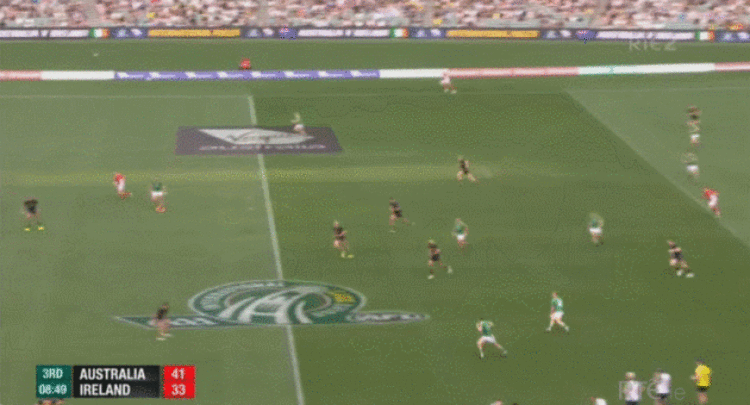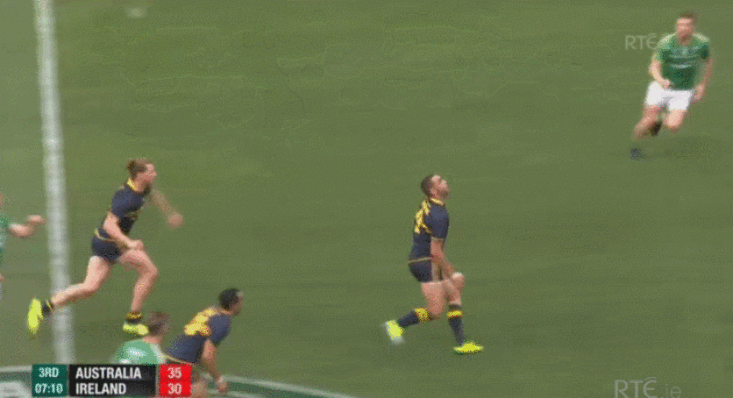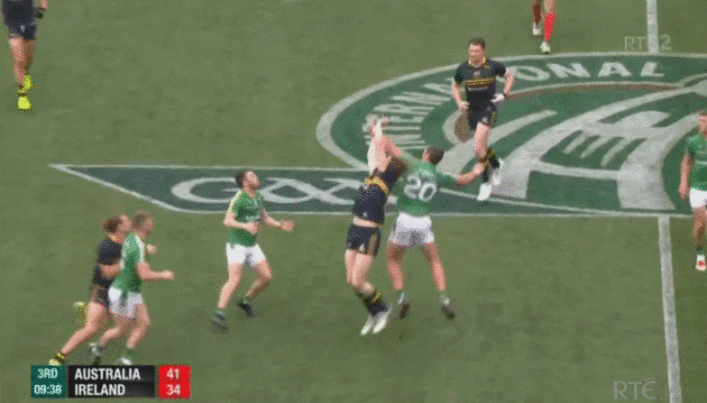FIVE MINUTES INTO the second-quarter of the International Rules opener in Adelaide, Ireland were 10 points in front and looked in complete control.
A goal and three overs from Michael Murphy in addition to two overs from Conor McManus handed Joe Kernan’s men a 24-14 lead.
The Aussies were rattled, but Chris Scott make a few key tactical switches that turned the game on its head. His moves paid off. By the midway point of the third quarter, Australia were 11 points to the good and threatening to put the series to bed.
To their credit, Ireland did finish on a strong note to keep the second leg alive. A 10-point margin is not insurmountable in a sport which awards six points for a goal, but Ireland must learn from the game in Adelaide Oval.
In fairness to Kernan, his preparations for the first test were hampered as the squad was hit by a vomiting bug in the build-up. Michael Murphy was among the first to complain about the illness, while Pearce Hanley, Enda Smith and Niall Murphy were also affected.
The latter two didn’t recover in time for Sunday’s game and weren’t even well enough to travel to the stadium, while there were minor injury concerns hanging over Gary Brennan and Paul Geaney.
Hanley broke his hand in the second-quarter and was subsequently ruled out of the second test. With just 21 players to chose from, Ireland could have wilted in the 35 degree Adelaide heat but a strong finish leaves plenty of hope ahead of tomorrow’s deciding game.
Darran Hughes and Ciaran Sheehan have since arrived into camp as late call-ups, while Enda Smith and Niall Murphy are back in training and will feature at the weekend.
From an Australian perspective, Port Adelaide’s All-Australian ruckman Paddy Ryder won’t feature in the second test, while Collingwood captain Scott Pendlebury has been ruled out with a broken finger.
Ryder was due in front of an Adelaide court on Wednesday to face charges which included assaulting a police officer during an early-morning brawl in the city in September. Charges against Ryder were dropped on Tuesday with police instead issuing the 29-year-old with a written caution. At the court on Wednesday, Ryder’s cousin pleaded guilty to rugby tackling a police officer.
Despite having the charges dropped, Ryder has opted against playing in the second Test in Perth. North Melbourne’s Shaun Higgins has been called-up to the squad instead.
Tenacious midfielder Joel Selwood, who missed the first test with an ankle injury, has been declared fit and is expected to start tomorrow.
Australian attack
Australia are extremely dangerous opponents and considering they only had their first collective session eight days ago, their kicking should be vastly improved this time around. Scott has also figured out the best way to puncture holes in Ireland’s defence.
Last Sunday, Australia started out the game with seven defenders and five forwards. Their plan was to get a running game going from deep and overpower the amateur team with their fitness levels. But Ireland, who’ve been collectively training for the guts of two months, had little issue in tracking the Aussie runners.
Ireland were well suited defensively to Australia’s slow build-up play and when they turned the ball over, Murphy and McManus were effective targets for long kick-passes from inside the 65.
Early on Australia were frequently forced to kick to the channels and they struggled to generate scores with some sloppy passes.
Midway through the second-quarter, Scott pushed back up to six attackers. They began to hit their three full-forwards with early deliveries towards the edge of the square once they hit the 45.
“That changed the whole game,” said former Australia International Rules manager Garry Lyon on Melbourne sports radio show SEN Breakfast earlier this week.
“They started kicking the ball longer into that area about 15m outside the goals. All of a sudden they started putting the Irish under pressure because big Ben Brown started to have an impact.”
The change in tactics gave Australia far more options in attack and the presence of 6’7″ Brown on the edge of the D handed them a serious outlet for high deliveries:
As their passing accuracy and ball retention improved in attack, Australia prevented Ireland from hitting Murphy and McManus on the type of counter-attack that was so effective in the opening two quarters.
Irish defence
At the other end, Cork defender Eoin Cadogan, who is a good five inches shorter than Brown, was assigned man-marking duties on the towering North Melbourne star but struggled to challenge him in the air:
Australia’s second goal in the fourth-quarter came from a second well-measured ball into the D, which the Irish full-back line completely misjudged.
The mix-up allowed West Coast star Luke Shuey palm past a helpless Niall Morgan to quell Ireland’s late comeback:
Ireland need to shore up defensively, but it’s nothing that can’t be fixed. Just like Australia’s use of the round ball will get better, Ireland’s understanding of the tackle rule should be far better after another week of practice.
Kernan’s side must cut out some naive errors at the back, like Killian Clarke’s mistake in the opening quarter. As the home side advanced down the left flank, Clarke raced out to attempt a block and left dangerman Chad Wingard unmarked on the 14m line:
It was a well-taken three-pointer for a left-footer like Wingard, but he would have never had the opportunity to shoot had Clarke played it smart and stayed put.
Irish attack
In the final two quarters, Ireland ventured away from the slow-tempo attacking gameplan that served them so well early on. Kernan said as much afterwards: “There were a lot of times in the third quarter when we got the mark inside the Australian 50 and we didn’t take it and take the shot.
“That was on four occasions we played on and lost the ball. As far as I’d be concerned, it was a minimum three overs, which is nine points, and all those overs are vital.”
Lyon believes Ireland need to make better use of their kick-passing ability if they’re to come out on top in Perth.
“They are the best kickers of the round ball,” he said. “All they should do is go slow, chip it round, kick the ball to one of theirs, mark it from any area from 30 to 35 and go back and kick their over. And do that all day. Tempo international rules. They can hit targets from 40m away.”
Ireland’s conversion rate in front of goal was poor, although McManus and Paul Geaney will be more aware of Brendon Goddard’s tenancy to rush out and close the shot down.
“He’s not really playing as a goalkeeper,” McManus told the Irish News after the game.
“We had one shot on goal and he didn’t get within an asses roar of it. If we can get chances, if we get more shots on goal he’s not going to save them.
“He’s very quick out and he’s very quick to cover that space as a sweeper but I certainly think if we can get one-on-one with him we can punish him. We left a lot of scores out there.”
What can Gaelic football learn from the Aussies?
It’s an interesting question. Although International Rules is a hybrid game, Australia brought some aspects from the AFL that may have caught the eye of Gaelic football coaches back in Ireland. Here are a few things that might be of interest:
1. The high press: In the last minute of stoppage-time in last September’s All-Ireland final, Dublin were a point up when David Clarke put his kick-out straight over the sideline. The Dubs played keep-ball and hand-passed all the way back to their goalkeeper for the final frantic minute as Mayo failed to touch the ball before before the long whistle.
If the Australians find themselves in a similar situation tomorrow, they’ll flood bodies into midfield and leave Ireland’s inside forwards unmarked. They did it against Ireland on numerous occasions in the first test:
It’s a high risk, high reward tactic, but it’s a no-brainer to use it if you’re losing and need to force a turnover the final minute of a game. Stephen Rochford, take note.
2. Sweeper-keeper: While most Gaelic football goalkeepers like to stay on their line at all times, Aussie keeper Brandon Goddard played like a sweeper-keeper and picked up any breaking ball off his full-back line.
“I think that caught them a bit off-guard because I think they’re so used to staying back in goal like you saw their goalie,” he told AFL.com after the game. ”They thought I would be on the (goal) line waiting for them.”
For high balls he helped his full-back by pushing up behind McManus and allowing his full-back to attack the ball:
The Essendon half-back mopped up plenty of ball and even pushed up to full-back on occasion to free up Scott Pendlebury and give Australia an extra body in midfield.
3. Hand speed: A couple of weeks ago, Paul Geaney was a guest on Off The Ball’s Saturday Panel when the conversation moved on to the upcoming International Rules series.
Geaney made an interesting point about how much practice the Australians put into hand-passing – or hand-balling it as they call it. He described a conversation he had with Dingle club-mate Mark O’Connor, who just completed his first campaign with AFL side Geelong.
“That’s one of the main skills they do, hand-balling they call it,” said Geaney. “Mark O’Connor from my club is out there. Basically the main skill they practice everyday is hand-balling – off the left and right just getting rid of the ball.
“In their game if you don’t get rid of it it’s a turnover and a free against you if you don’t get the ball out of your hands. Anywhere within five metres you’re game for a tackle so it’s all about moving it on.” Their fast hands were evident last weekend:
Despite their unfamiliarity with the round ball, the Australians demonstrated outstanding hand speed. When they attack in midfield the man in possession often has a runner either side:
4. Limit to six hand-passes: This one applies more to administration than coaches, but putting a limit on hand-passing could be worth trialling in the coming few years. The rules of International Rules state that the ball must be kicked after six consecutive hand-passes.
“Six hand-passes and then you have to kick it – something maybe to look at in our own game,” said Ireland’s Shane Walsh this week. “It would speed things up.”
The main sticking point might the fact there is only one referee in GAA, as opposed to two in International Rules. The officials may find it difficult to keep tabs on the number of hand-passes in a fast-paced Gaelic football game, particularly at club level.
- Australia v Ireland, Domain Stadium, Perth, 8.45am (Irish time) RTÉ 2
Buy The42’s new book, Behind The Lines, here:

